Level 4 Business Accounting: Uses & Limitations of Financials
VerifiedAdded on 2023/06/10
|12
|3293
|446
Essay
AI Summary
This essay critically evaluates the uses and limitations of the main corporate financial statements: the Income Statement, the Statement of Financial Position, and the Cash Flow Statement. It discusses how the Income Statement helps track revenues and expenses but is subject to estimates and qualitative omissions. The Statement of Financial Position provides insights into a company's financial condition but relies on assumptions and can be manipulated. The Cash Flow Statement offers a clear view of cash transactions, unaffected by accounting policies, but lacks context without other financial statements and does not reflect accrual-based information. The essay concludes that while financial statements are valuable, they are subject to bias and should be interpreted with caution.

03 August 2018
Business Accounting
Corporate financial statements, their uses, and their
limitations.
Business Accounting
Corporate financial statements, their uses, and their
limitations.
Paraphrase This Document
Need a fresh take? Get an instant paraphrase of this document with our AI Paraphraser
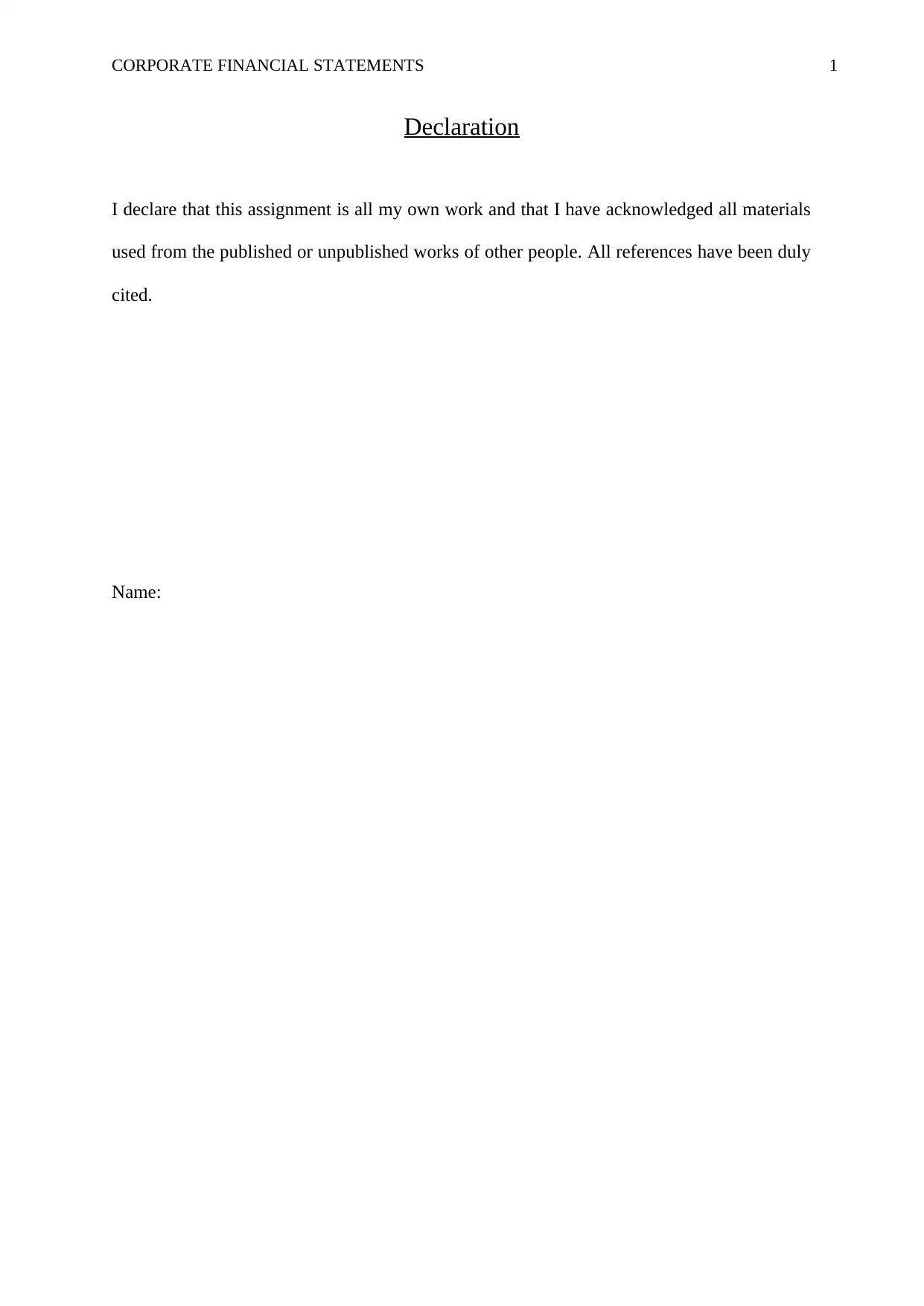
CORPORATE FINANCIAL STATEMENTS 1
Declaration
I declare that this assignment is all my own work and that I have acknowledged all materials
used from the published or unpublished works of other people. All references have been duly
cited.
Name:
Declaration
I declare that this assignment is all my own work and that I have acknowledged all materials
used from the published or unpublished works of other people. All references have been duly
cited.
Name:
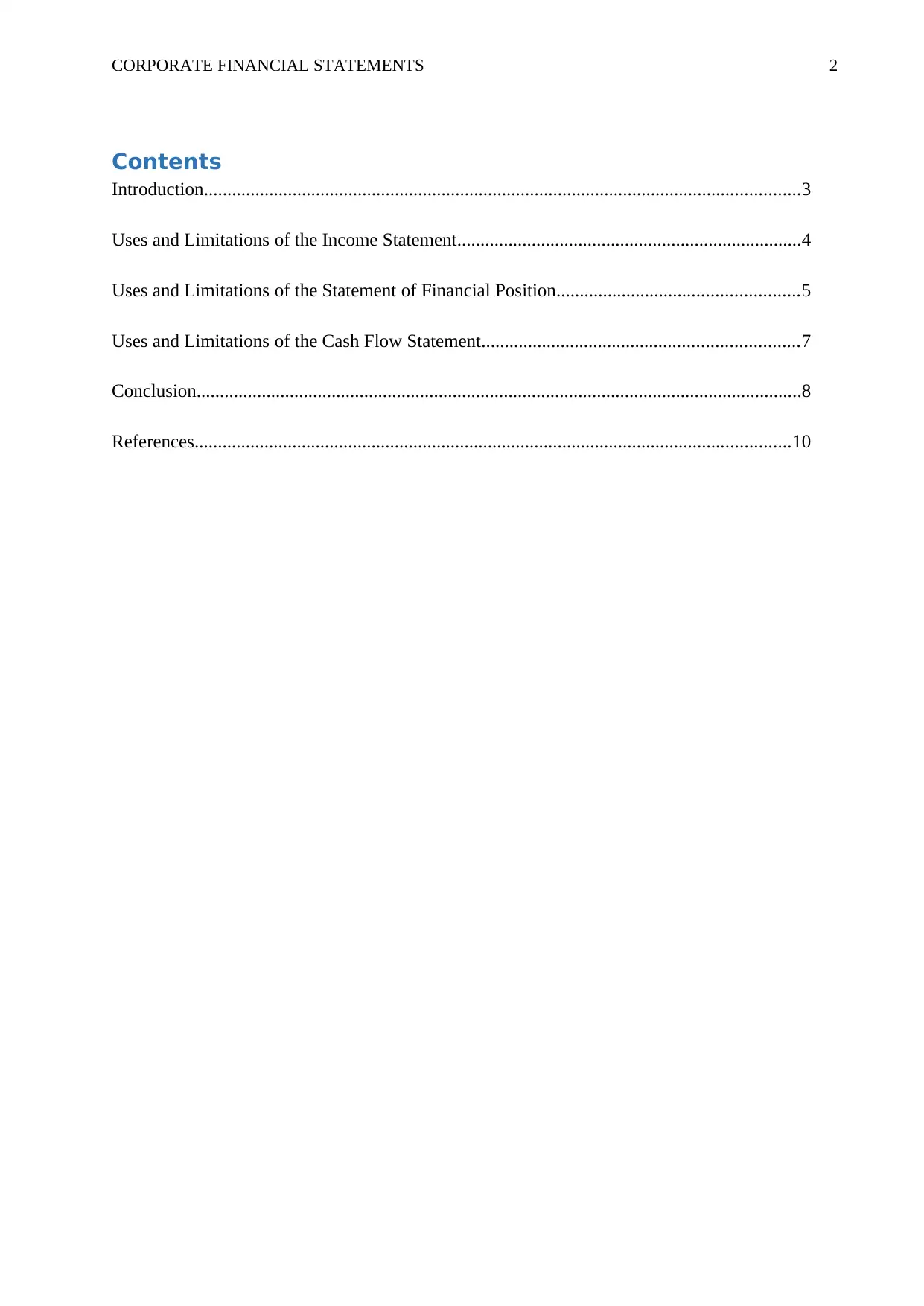
CORPORATE FINANCIAL STATEMENTS 2
Contents
Introduction................................................................................................................................3
Uses and Limitations of the Income Statement..........................................................................4
Uses and Limitations of the Statement of Financial Position....................................................5
Uses and Limitations of the Cash Flow Statement....................................................................7
Conclusion..................................................................................................................................8
References................................................................................................................................10
Contents
Introduction................................................................................................................................3
Uses and Limitations of the Income Statement..........................................................................4
Uses and Limitations of the Statement of Financial Position....................................................5
Uses and Limitations of the Cash Flow Statement....................................................................7
Conclusion..................................................................................................................................8
References................................................................................................................................10
⊘ This is a preview!⊘
Do you want full access?
Subscribe today to unlock all pages.

Trusted by 1+ million students worldwide
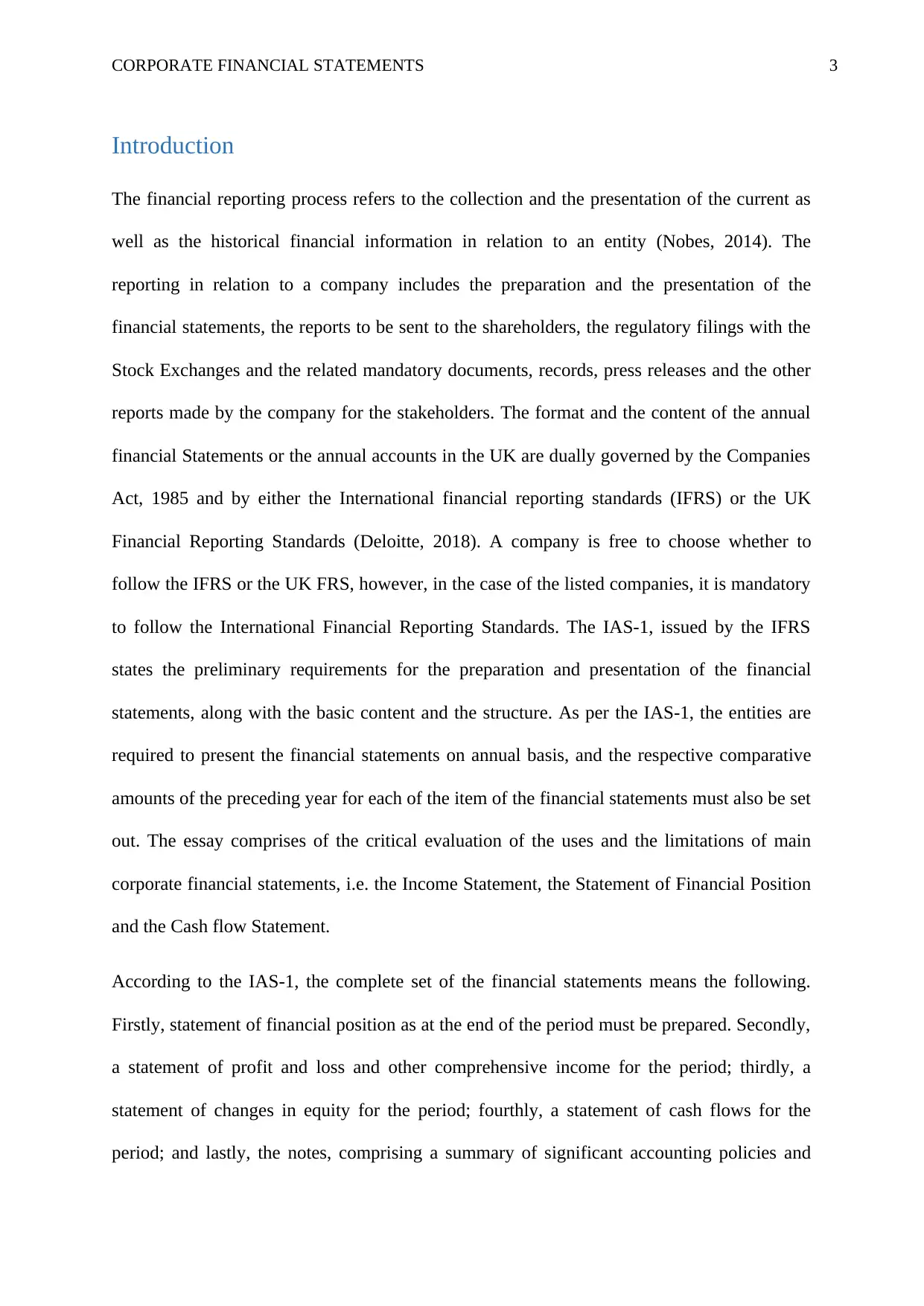
CORPORATE FINANCIAL STATEMENTS 3
Introduction
The financial reporting process refers to the collection and the presentation of the current as
well as the historical financial information in relation to an entity (Nobes, 2014). The
reporting in relation to a company includes the preparation and the presentation of the
financial statements, the reports to be sent to the shareholders, the regulatory filings with the
Stock Exchanges and the related mandatory documents, records, press releases and the other
reports made by the company for the stakeholders. The format and the content of the annual
financial Statements or the annual accounts in the UK are dually governed by the Companies
Act, 1985 and by either the International financial reporting standards (IFRS) or the UK
Financial Reporting Standards (Deloitte, 2018). A company is free to choose whether to
follow the IFRS or the UK FRS, however, in the case of the listed companies, it is mandatory
to follow the International Financial Reporting Standards. The IAS-1, issued by the IFRS
states the preliminary requirements for the preparation and presentation of the financial
statements, along with the basic content and the structure. As per the IAS-1, the entities are
required to present the financial statements on annual basis, and the respective comparative
amounts of the preceding year for each of the item of the financial statements must also be set
out. The essay comprises of the critical evaluation of the uses and the limitations of main
corporate financial statements, i.e. the Income Statement, the Statement of Financial Position
and the Cash flow Statement.
According to the IAS-1, the complete set of the financial statements means the following.
Firstly, statement of financial position as at the end of the period must be prepared. Secondly,
a statement of profit and loss and other comprehensive income for the period; thirdly, a
statement of changes in equity for the period; fourthly, a statement of cash flows for the
period; and lastly, the notes, comprising a summary of significant accounting policies and
Introduction
The financial reporting process refers to the collection and the presentation of the current as
well as the historical financial information in relation to an entity (Nobes, 2014). The
reporting in relation to a company includes the preparation and the presentation of the
financial statements, the reports to be sent to the shareholders, the regulatory filings with the
Stock Exchanges and the related mandatory documents, records, press releases and the other
reports made by the company for the stakeholders. The format and the content of the annual
financial Statements or the annual accounts in the UK are dually governed by the Companies
Act, 1985 and by either the International financial reporting standards (IFRS) or the UK
Financial Reporting Standards (Deloitte, 2018). A company is free to choose whether to
follow the IFRS or the UK FRS, however, in the case of the listed companies, it is mandatory
to follow the International Financial Reporting Standards. The IAS-1, issued by the IFRS
states the preliminary requirements for the preparation and presentation of the financial
statements, along with the basic content and the structure. As per the IAS-1, the entities are
required to present the financial statements on annual basis, and the respective comparative
amounts of the preceding year for each of the item of the financial statements must also be set
out. The essay comprises of the critical evaluation of the uses and the limitations of main
corporate financial statements, i.e. the Income Statement, the Statement of Financial Position
and the Cash flow Statement.
According to the IAS-1, the complete set of the financial statements means the following.
Firstly, statement of financial position as at the end of the period must be prepared. Secondly,
a statement of profit and loss and other comprehensive income for the period; thirdly, a
statement of changes in equity for the period; fourthly, a statement of cash flows for the
period; and lastly, the notes, comprising a summary of significant accounting policies and
Paraphrase This Document
Need a fresh take? Get an instant paraphrase of this document with our AI Paraphraser
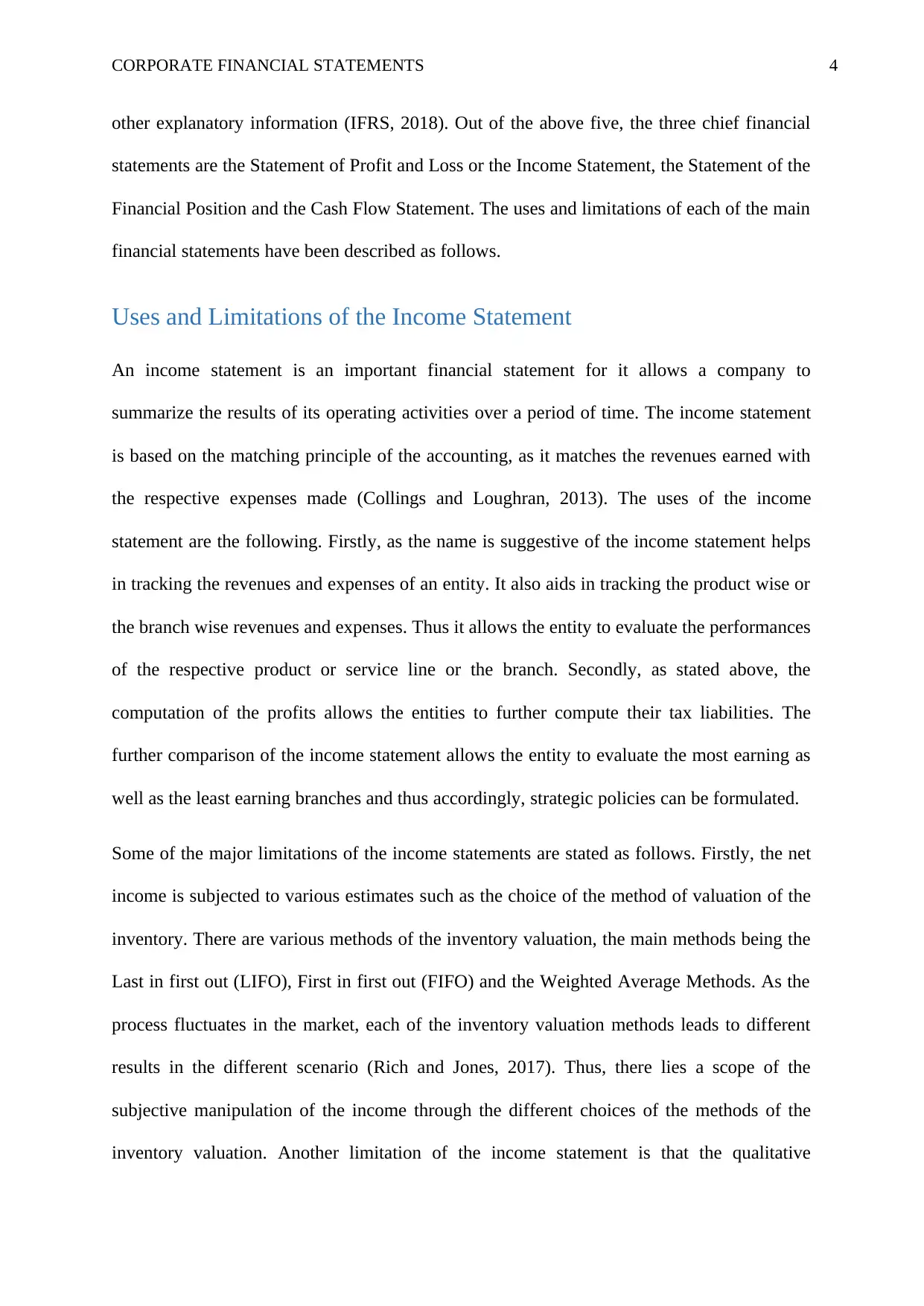
CORPORATE FINANCIAL STATEMENTS 4
other explanatory information (IFRS, 2018). Out of the above five, the three chief financial
statements are the Statement of Profit and Loss or the Income Statement, the Statement of the
Financial Position and the Cash Flow Statement. The uses and limitations of each of the main
financial statements have been described as follows.
Uses and Limitations of the Income Statement
An income statement is an important financial statement for it allows a company to
summarize the results of its operating activities over a period of time. The income statement
is based on the matching principle of the accounting, as it matches the revenues earned with
the respective expenses made (Collings and Loughran, 2013). The uses of the income
statement are the following. Firstly, as the name is suggestive of the income statement helps
in tracking the revenues and expenses of an entity. It also aids in tracking the product wise or
the branch wise revenues and expenses. Thus it allows the entity to evaluate the performances
of the respective product or service line or the branch. Secondly, as stated above, the
computation of the profits allows the entities to further compute their tax liabilities. The
further comparison of the income statement allows the entity to evaluate the most earning as
well as the least earning branches and thus accordingly, strategic policies can be formulated.
Some of the major limitations of the income statements are stated as follows. Firstly, the net
income is subjected to various estimates such as the choice of the method of valuation of the
inventory. There are various methods of the inventory valuation, the main methods being the
Last in first out (LIFO), First in first out (FIFO) and the Weighted Average Methods. As the
process fluctuates in the market, each of the inventory valuation methods leads to different
results in the different scenario (Rich and Jones, 2017). Thus, there lies a scope of the
subjective manipulation of the income through the different choices of the methods of the
inventory valuation. Another limitation of the income statement is that the qualitative
other explanatory information (IFRS, 2018). Out of the above five, the three chief financial
statements are the Statement of Profit and Loss or the Income Statement, the Statement of the
Financial Position and the Cash Flow Statement. The uses and limitations of each of the main
financial statements have been described as follows.
Uses and Limitations of the Income Statement
An income statement is an important financial statement for it allows a company to
summarize the results of its operating activities over a period of time. The income statement
is based on the matching principle of the accounting, as it matches the revenues earned with
the respective expenses made (Collings and Loughran, 2013). The uses of the income
statement are the following. Firstly, as the name is suggestive of the income statement helps
in tracking the revenues and expenses of an entity. It also aids in tracking the product wise or
the branch wise revenues and expenses. Thus it allows the entity to evaluate the performances
of the respective product or service line or the branch. Secondly, as stated above, the
computation of the profits allows the entities to further compute their tax liabilities. The
further comparison of the income statement allows the entity to evaluate the most earning as
well as the least earning branches and thus accordingly, strategic policies can be formulated.
Some of the major limitations of the income statements are stated as follows. Firstly, the net
income is subjected to various estimates such as the choice of the method of valuation of the
inventory. There are various methods of the inventory valuation, the main methods being the
Last in first out (LIFO), First in first out (FIFO) and the Weighted Average Methods. As the
process fluctuates in the market, each of the inventory valuation methods leads to different
results in the different scenario (Rich and Jones, 2017). Thus, there lies a scope of the
subjective manipulation of the income through the different choices of the methods of the
inventory valuation. Another limitation of the income statement is that the qualitative
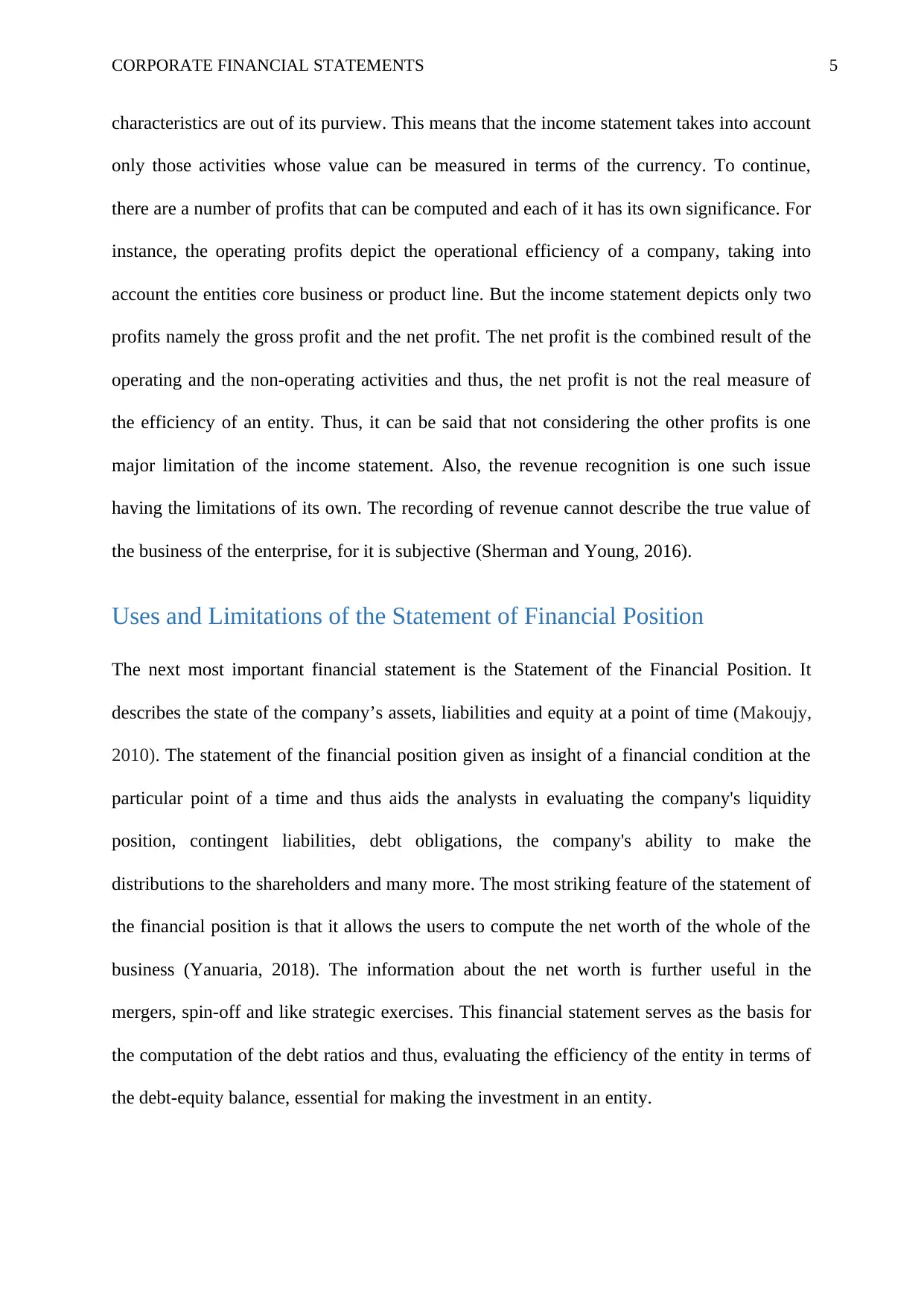
CORPORATE FINANCIAL STATEMENTS 5
characteristics are out of its purview. This means that the income statement takes into account
only those activities whose value can be measured in terms of the currency. To continue,
there are a number of profits that can be computed and each of it has its own significance. For
instance, the operating profits depict the operational efficiency of a company, taking into
account the entities core business or product line. But the income statement depicts only two
profits namely the gross profit and the net profit. The net profit is the combined result of the
operating and the non-operating activities and thus, the net profit is not the real measure of
the efficiency of an entity. Thus, it can be said that not considering the other profits is one
major limitation of the income statement. Also, the revenue recognition is one such issue
having the limitations of its own. The recording of revenue cannot describe the true value of
the business of the enterprise, for it is subjective (Sherman and Young, 2016).
Uses and Limitations of the Statement of Financial Position
The next most important financial statement is the Statement of the Financial Position. It
describes the state of the company’s assets, liabilities and equity at a point of time (Makoujy,
2010). The statement of the financial position given as insight of a financial condition at the
particular point of a time and thus aids the analysts in evaluating the company's liquidity
position, contingent liabilities, debt obligations, the company's ability to make the
distributions to the shareholders and many more. The most striking feature of the statement of
the financial position is that it allows the users to compute the net worth of the whole of the
business (Yanuaria, 2018). The information about the net worth is further useful in the
mergers, spin-off and like strategic exercises. This financial statement serves as the basis for
the computation of the debt ratios and thus, evaluating the efficiency of the entity in terms of
the debt-equity balance, essential for making the investment in an entity.
characteristics are out of its purview. This means that the income statement takes into account
only those activities whose value can be measured in terms of the currency. To continue,
there are a number of profits that can be computed and each of it has its own significance. For
instance, the operating profits depict the operational efficiency of a company, taking into
account the entities core business or product line. But the income statement depicts only two
profits namely the gross profit and the net profit. The net profit is the combined result of the
operating and the non-operating activities and thus, the net profit is not the real measure of
the efficiency of an entity. Thus, it can be said that not considering the other profits is one
major limitation of the income statement. Also, the revenue recognition is one such issue
having the limitations of its own. The recording of revenue cannot describe the true value of
the business of the enterprise, for it is subjective (Sherman and Young, 2016).
Uses and Limitations of the Statement of Financial Position
The next most important financial statement is the Statement of the Financial Position. It
describes the state of the company’s assets, liabilities and equity at a point of time (Makoujy,
2010). The statement of the financial position given as insight of a financial condition at the
particular point of a time and thus aids the analysts in evaluating the company's liquidity
position, contingent liabilities, debt obligations, the company's ability to make the
distributions to the shareholders and many more. The most striking feature of the statement of
the financial position is that it allows the users to compute the net worth of the whole of the
business (Yanuaria, 2018). The information about the net worth is further useful in the
mergers, spin-off and like strategic exercises. This financial statement serves as the basis for
the computation of the debt ratios and thus, evaluating the efficiency of the entity in terms of
the debt-equity balance, essential for making the investment in an entity.
⊘ This is a preview!⊘
Do you want full access?
Subscribe today to unlock all pages.

Trusted by 1+ million students worldwide
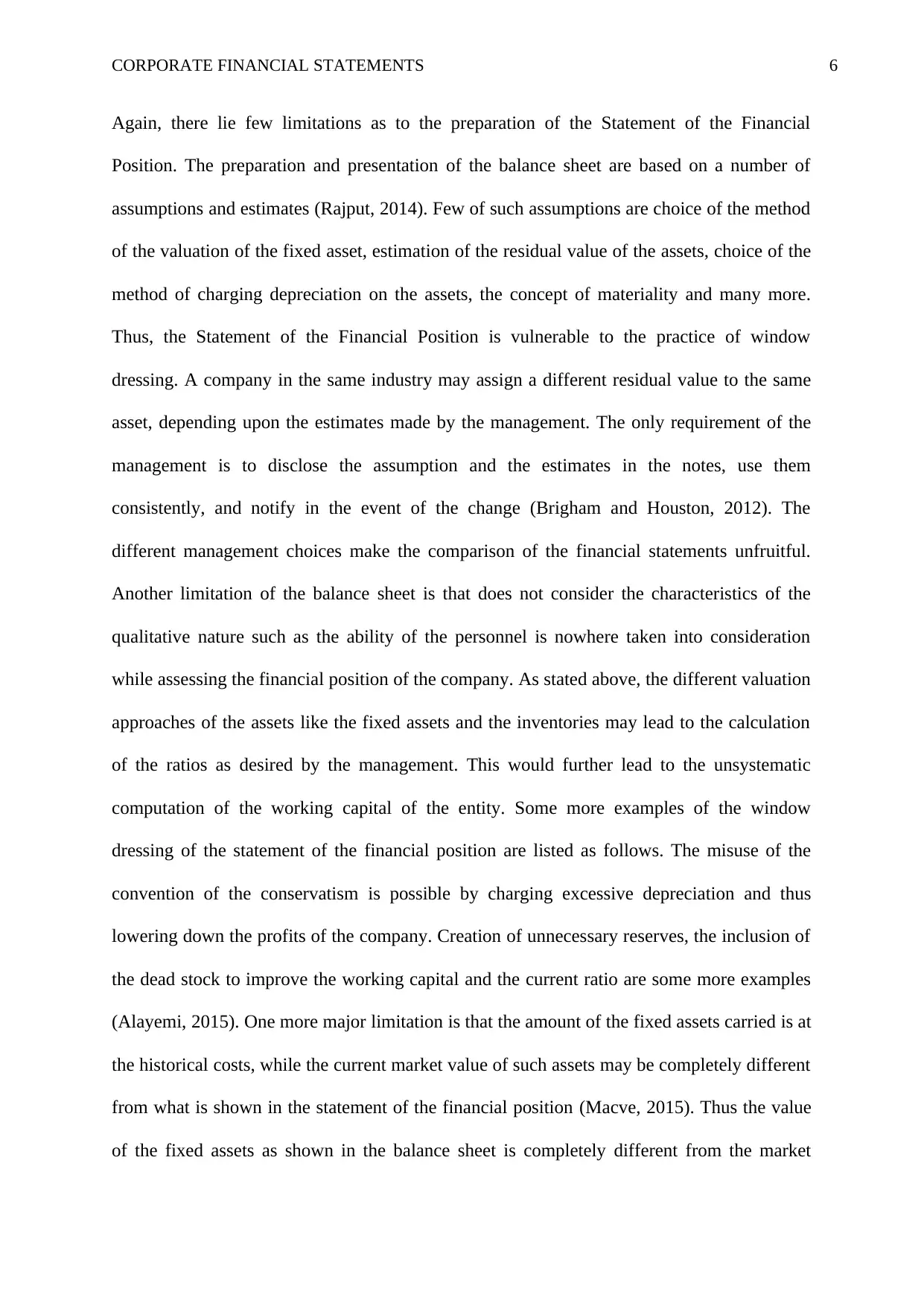
CORPORATE FINANCIAL STATEMENTS 6
Again, there lie few limitations as to the preparation of the Statement of the Financial
Position. The preparation and presentation of the balance sheet are based on a number of
assumptions and estimates (Rajput, 2014). Few of such assumptions are choice of the method
of the valuation of the fixed asset, estimation of the residual value of the assets, choice of the
method of charging depreciation on the assets, the concept of materiality and many more.
Thus, the Statement of the Financial Position is vulnerable to the practice of window
dressing. A company in the same industry may assign a different residual value to the same
asset, depending upon the estimates made by the management. The only requirement of the
management is to disclose the assumption and the estimates in the notes, use them
consistently, and notify in the event of the change (Brigham and Houston, 2012). The
different management choices make the comparison of the financial statements unfruitful.
Another limitation of the balance sheet is that does not consider the characteristics of the
qualitative nature such as the ability of the personnel is nowhere taken into consideration
while assessing the financial position of the company. As stated above, the different valuation
approaches of the assets like the fixed assets and the inventories may lead to the calculation
of the ratios as desired by the management. This would further lead to the unsystematic
computation of the working capital of the entity. Some more examples of the window
dressing of the statement of the financial position are listed as follows. The misuse of the
convention of the conservatism is possible by charging excessive depreciation and thus
lowering down the profits of the company. Creation of unnecessary reserves, the inclusion of
the dead stock to improve the working capital and the current ratio are some more examples
(Alayemi, 2015). One more major limitation is that the amount of the fixed assets carried is at
the historical costs, while the current market value of such assets may be completely different
from what is shown in the statement of the financial position (Macve, 2015). Thus the value
of the fixed assets as shown in the balance sheet is completely different from the market
Again, there lie few limitations as to the preparation of the Statement of the Financial
Position. The preparation and presentation of the balance sheet are based on a number of
assumptions and estimates (Rajput, 2014). Few of such assumptions are choice of the method
of the valuation of the fixed asset, estimation of the residual value of the assets, choice of the
method of charging depreciation on the assets, the concept of materiality and many more.
Thus, the Statement of the Financial Position is vulnerable to the practice of window
dressing. A company in the same industry may assign a different residual value to the same
asset, depending upon the estimates made by the management. The only requirement of the
management is to disclose the assumption and the estimates in the notes, use them
consistently, and notify in the event of the change (Brigham and Houston, 2012). The
different management choices make the comparison of the financial statements unfruitful.
Another limitation of the balance sheet is that does not consider the characteristics of the
qualitative nature such as the ability of the personnel is nowhere taken into consideration
while assessing the financial position of the company. As stated above, the different valuation
approaches of the assets like the fixed assets and the inventories may lead to the calculation
of the ratios as desired by the management. This would further lead to the unsystematic
computation of the working capital of the entity. Some more examples of the window
dressing of the statement of the financial position are listed as follows. The misuse of the
convention of the conservatism is possible by charging excessive depreciation and thus
lowering down the profits of the company. Creation of unnecessary reserves, the inclusion of
the dead stock to improve the working capital and the current ratio are some more examples
(Alayemi, 2015). One more major limitation is that the amount of the fixed assets carried is at
the historical costs, while the current market value of such assets may be completely different
from what is shown in the statement of the financial position (Macve, 2015). Thus the value
of the fixed assets as shown in the balance sheet is completely different from the market
Paraphrase This Document
Need a fresh take? Get an instant paraphrase of this document with our AI Paraphraser
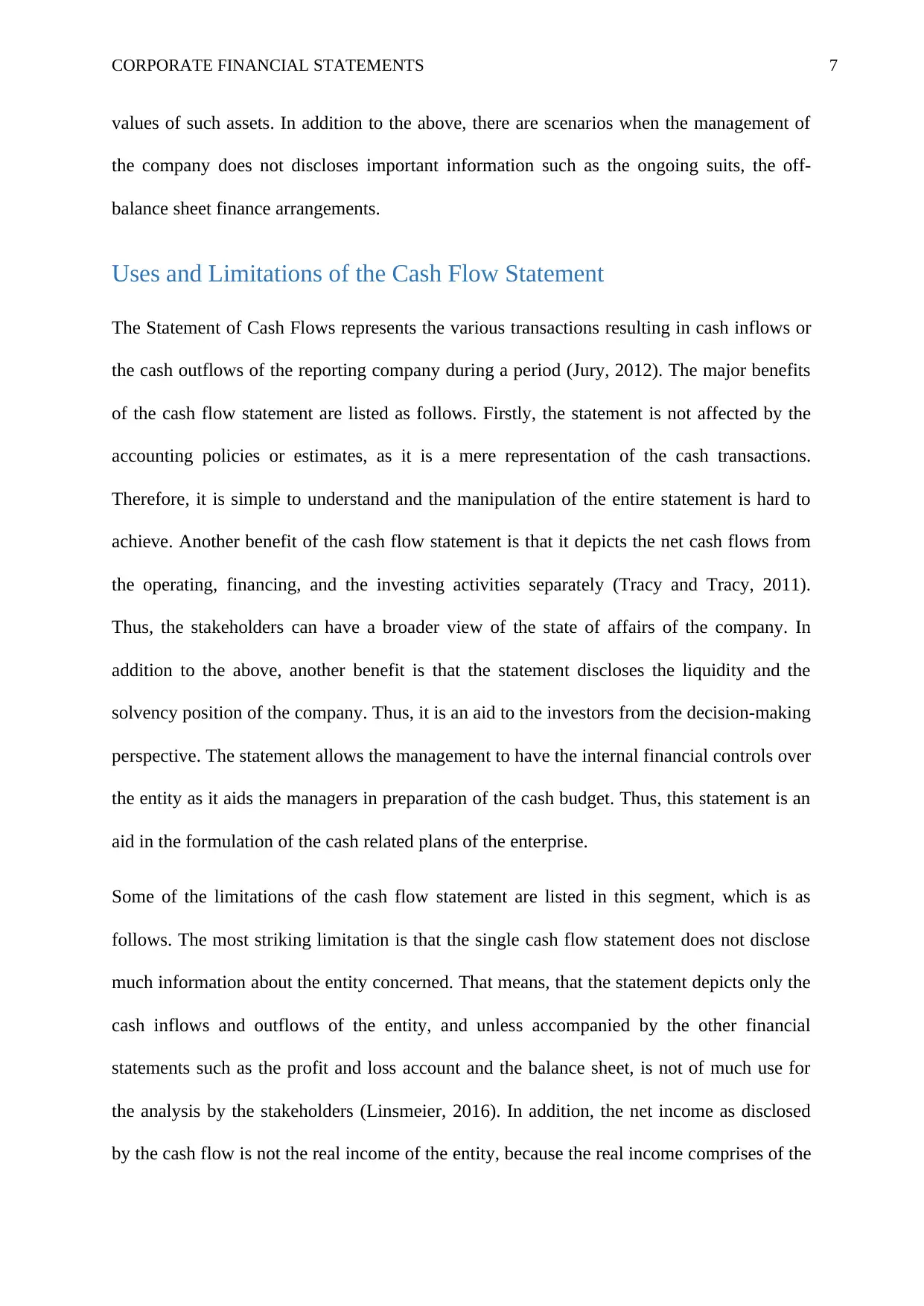
CORPORATE FINANCIAL STATEMENTS 7
values of such assets. In addition to the above, there are scenarios when the management of
the company does not discloses important information such as the ongoing suits, the off-
balance sheet finance arrangements.
Uses and Limitations of the Cash Flow Statement
The Statement of Cash Flows represents the various transactions resulting in cash inflows or
the cash outflows of the reporting company during a period (Jury, 2012). The major benefits
of the cash flow statement are listed as follows. Firstly, the statement is not affected by the
accounting policies or estimates, as it is a mere representation of the cash transactions.
Therefore, it is simple to understand and the manipulation of the entire statement is hard to
achieve. Another benefit of the cash flow statement is that it depicts the net cash flows from
the operating, financing, and the investing activities separately (Tracy and Tracy, 2011).
Thus, the stakeholders can have a broader view of the state of affairs of the company. In
addition to the above, another benefit is that the statement discloses the liquidity and the
solvency position of the company. Thus, it is an aid to the investors from the decision-making
perspective. The statement allows the management to have the internal financial controls over
the entity as it aids the managers in preparation of the cash budget. Thus, this statement is an
aid in the formulation of the cash related plans of the enterprise.
Some of the limitations of the cash flow statement are listed in this segment, which is as
follows. The most striking limitation is that the single cash flow statement does not disclose
much information about the entity concerned. That means, that the statement depicts only the
cash inflows and outflows of the entity, and unless accompanied by the other financial
statements such as the profit and loss account and the balance sheet, is not of much use for
the analysis by the stakeholders (Linsmeier, 2016). In addition, the net income as disclosed
by the cash flow is not the real income of the entity, because the real income comprises of the
values of such assets. In addition to the above, there are scenarios when the management of
the company does not discloses important information such as the ongoing suits, the off-
balance sheet finance arrangements.
Uses and Limitations of the Cash Flow Statement
The Statement of Cash Flows represents the various transactions resulting in cash inflows or
the cash outflows of the reporting company during a period (Jury, 2012). The major benefits
of the cash flow statement are listed as follows. Firstly, the statement is not affected by the
accounting policies or estimates, as it is a mere representation of the cash transactions.
Therefore, it is simple to understand and the manipulation of the entire statement is hard to
achieve. Another benefit of the cash flow statement is that it depicts the net cash flows from
the operating, financing, and the investing activities separately (Tracy and Tracy, 2011).
Thus, the stakeholders can have a broader view of the state of affairs of the company. In
addition to the above, another benefit is that the statement discloses the liquidity and the
solvency position of the company. Thus, it is an aid to the investors from the decision-making
perspective. The statement allows the management to have the internal financial controls over
the entity as it aids the managers in preparation of the cash budget. Thus, this statement is an
aid in the formulation of the cash related plans of the enterprise.
Some of the limitations of the cash flow statement are listed in this segment, which is as
follows. The most striking limitation is that the single cash flow statement does not disclose
much information about the entity concerned. That means, that the statement depicts only the
cash inflows and outflows of the entity, and unless accompanied by the other financial
statements such as the profit and loss account and the balance sheet, is not of much use for
the analysis by the stakeholders (Linsmeier, 2016). In addition, the net income as disclosed
by the cash flow is not the real income of the entity, because the real income comprises of the
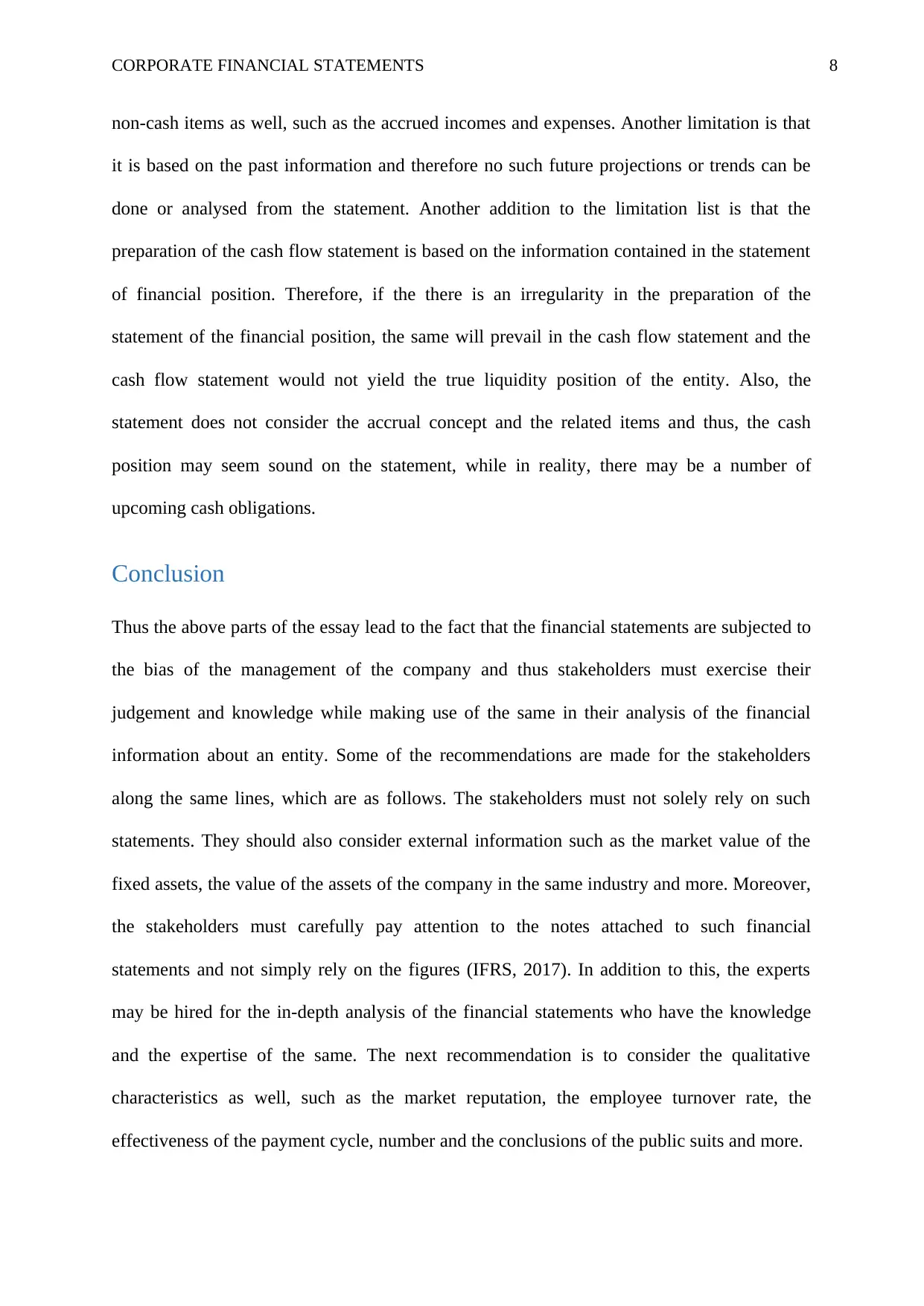
CORPORATE FINANCIAL STATEMENTS 8
non-cash items as well, such as the accrued incomes and expenses. Another limitation is that
it is based on the past information and therefore no such future projections or trends can be
done or analysed from the statement. Another addition to the limitation list is that the
preparation of the cash flow statement is based on the information contained in the statement
of financial position. Therefore, if the there is an irregularity in the preparation of the
statement of the financial position, the same will prevail in the cash flow statement and the
cash flow statement would not yield the true liquidity position of the entity. Also, the
statement does not consider the accrual concept and the related items and thus, the cash
position may seem sound on the statement, while in reality, there may be a number of
upcoming cash obligations.
Conclusion
Thus the above parts of the essay lead to the fact that the financial statements are subjected to
the bias of the management of the company and thus stakeholders must exercise their
judgement and knowledge while making use of the same in their analysis of the financial
information about an entity. Some of the recommendations are made for the stakeholders
along the same lines, which are as follows. The stakeholders must not solely rely on such
statements. They should also consider external information such as the market value of the
fixed assets, the value of the assets of the company in the same industry and more. Moreover,
the stakeholders must carefully pay attention to the notes attached to such financial
statements and not simply rely on the figures (IFRS, 2017). In addition to this, the experts
may be hired for the in-depth analysis of the financial statements who have the knowledge
and the expertise of the same. The next recommendation is to consider the qualitative
characteristics as well, such as the market reputation, the employee turnover rate, the
effectiveness of the payment cycle, number and the conclusions of the public suits and more.
non-cash items as well, such as the accrued incomes and expenses. Another limitation is that
it is based on the past information and therefore no such future projections or trends can be
done or analysed from the statement. Another addition to the limitation list is that the
preparation of the cash flow statement is based on the information contained in the statement
of financial position. Therefore, if the there is an irregularity in the preparation of the
statement of the financial position, the same will prevail in the cash flow statement and the
cash flow statement would not yield the true liquidity position of the entity. Also, the
statement does not consider the accrual concept and the related items and thus, the cash
position may seem sound on the statement, while in reality, there may be a number of
upcoming cash obligations.
Conclusion
Thus the above parts of the essay lead to the fact that the financial statements are subjected to
the bias of the management of the company and thus stakeholders must exercise their
judgement and knowledge while making use of the same in their analysis of the financial
information about an entity. Some of the recommendations are made for the stakeholders
along the same lines, which are as follows. The stakeholders must not solely rely on such
statements. They should also consider external information such as the market value of the
fixed assets, the value of the assets of the company in the same industry and more. Moreover,
the stakeholders must carefully pay attention to the notes attached to such financial
statements and not simply rely on the figures (IFRS, 2017). In addition to this, the experts
may be hired for the in-depth analysis of the financial statements who have the knowledge
and the expertise of the same. The next recommendation is to consider the qualitative
characteristics as well, such as the market reputation, the employee turnover rate, the
effectiveness of the payment cycle, number and the conclusions of the public suits and more.
⊘ This is a preview!⊘
Do you want full access?
Subscribe today to unlock all pages.

Trusted by 1+ million students worldwide
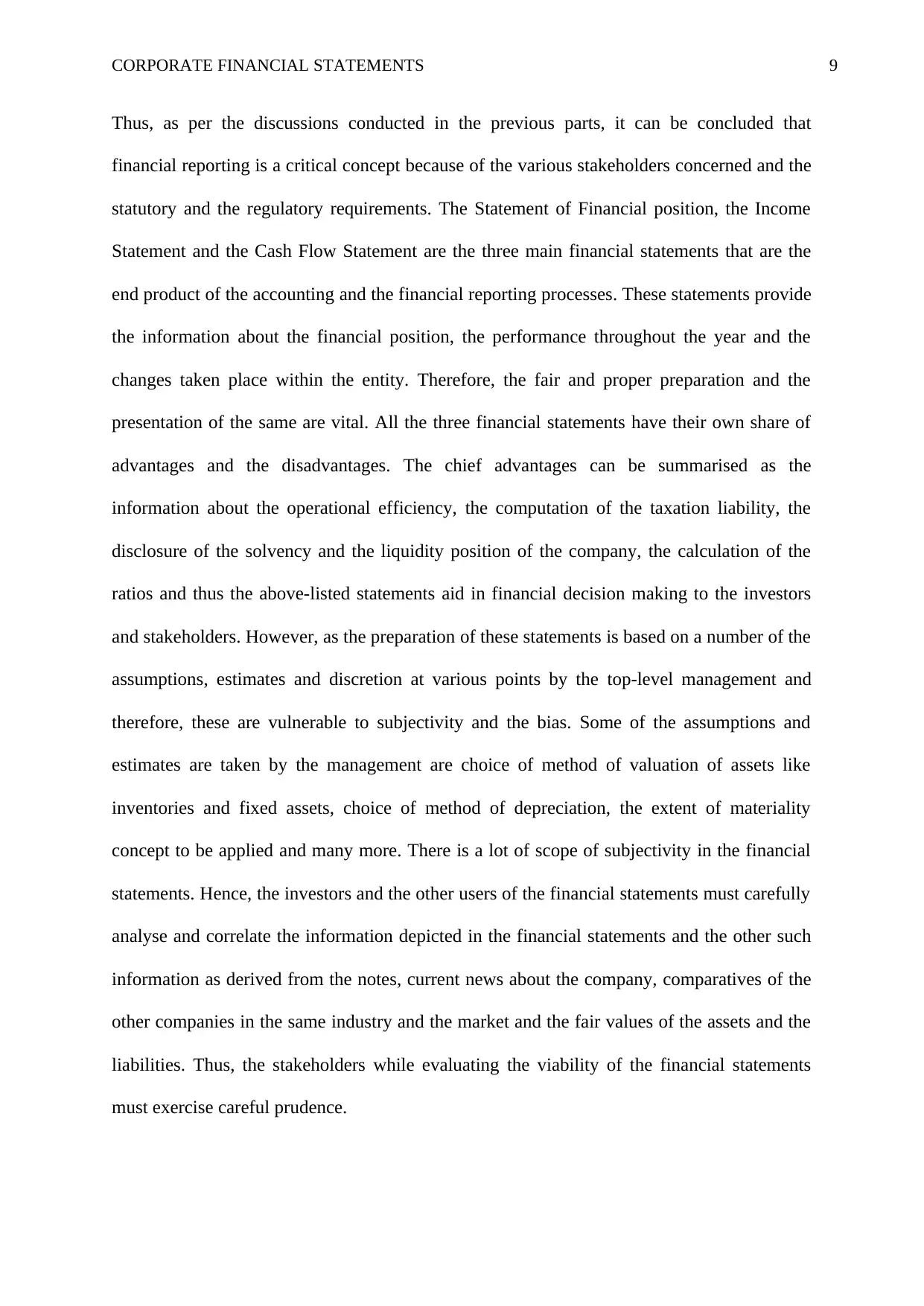
CORPORATE FINANCIAL STATEMENTS 9
Thus, as per the discussions conducted in the previous parts, it can be concluded that
financial reporting is a critical concept because of the various stakeholders concerned and the
statutory and the regulatory requirements. The Statement of Financial position, the Income
Statement and the Cash Flow Statement are the three main financial statements that are the
end product of the accounting and the financial reporting processes. These statements provide
the information about the financial position, the performance throughout the year and the
changes taken place within the entity. Therefore, the fair and proper preparation and the
presentation of the same are vital. All the three financial statements have their own share of
advantages and the disadvantages. The chief advantages can be summarised as the
information about the operational efficiency, the computation of the taxation liability, the
disclosure of the solvency and the liquidity position of the company, the calculation of the
ratios and thus the above-listed statements aid in financial decision making to the investors
and stakeholders. However, as the preparation of these statements is based on a number of the
assumptions, estimates and discretion at various points by the top-level management and
therefore, these are vulnerable to subjectivity and the bias. Some of the assumptions and
estimates are taken by the management are choice of method of valuation of assets like
inventories and fixed assets, choice of method of depreciation, the extent of materiality
concept to be applied and many more. There is a lot of scope of subjectivity in the financial
statements. Hence, the investors and the other users of the financial statements must carefully
analyse and correlate the information depicted in the financial statements and the other such
information as derived from the notes, current news about the company, comparatives of the
other companies in the same industry and the market and the fair values of the assets and the
liabilities. Thus, the stakeholders while evaluating the viability of the financial statements
must exercise careful prudence.
Thus, as per the discussions conducted in the previous parts, it can be concluded that
financial reporting is a critical concept because of the various stakeholders concerned and the
statutory and the regulatory requirements. The Statement of Financial position, the Income
Statement and the Cash Flow Statement are the three main financial statements that are the
end product of the accounting and the financial reporting processes. These statements provide
the information about the financial position, the performance throughout the year and the
changes taken place within the entity. Therefore, the fair and proper preparation and the
presentation of the same are vital. All the three financial statements have their own share of
advantages and the disadvantages. The chief advantages can be summarised as the
information about the operational efficiency, the computation of the taxation liability, the
disclosure of the solvency and the liquidity position of the company, the calculation of the
ratios and thus the above-listed statements aid in financial decision making to the investors
and stakeholders. However, as the preparation of these statements is based on a number of the
assumptions, estimates and discretion at various points by the top-level management and
therefore, these are vulnerable to subjectivity and the bias. Some of the assumptions and
estimates are taken by the management are choice of method of valuation of assets like
inventories and fixed assets, choice of method of depreciation, the extent of materiality
concept to be applied and many more. There is a lot of scope of subjectivity in the financial
statements. Hence, the investors and the other users of the financial statements must carefully
analyse and correlate the information depicted in the financial statements and the other such
information as derived from the notes, current news about the company, comparatives of the
other companies in the same industry and the market and the fair values of the assets and the
liabilities. Thus, the stakeholders while evaluating the viability of the financial statements
must exercise careful prudence.
Paraphrase This Document
Need a fresh take? Get an instant paraphrase of this document with our AI Paraphraser
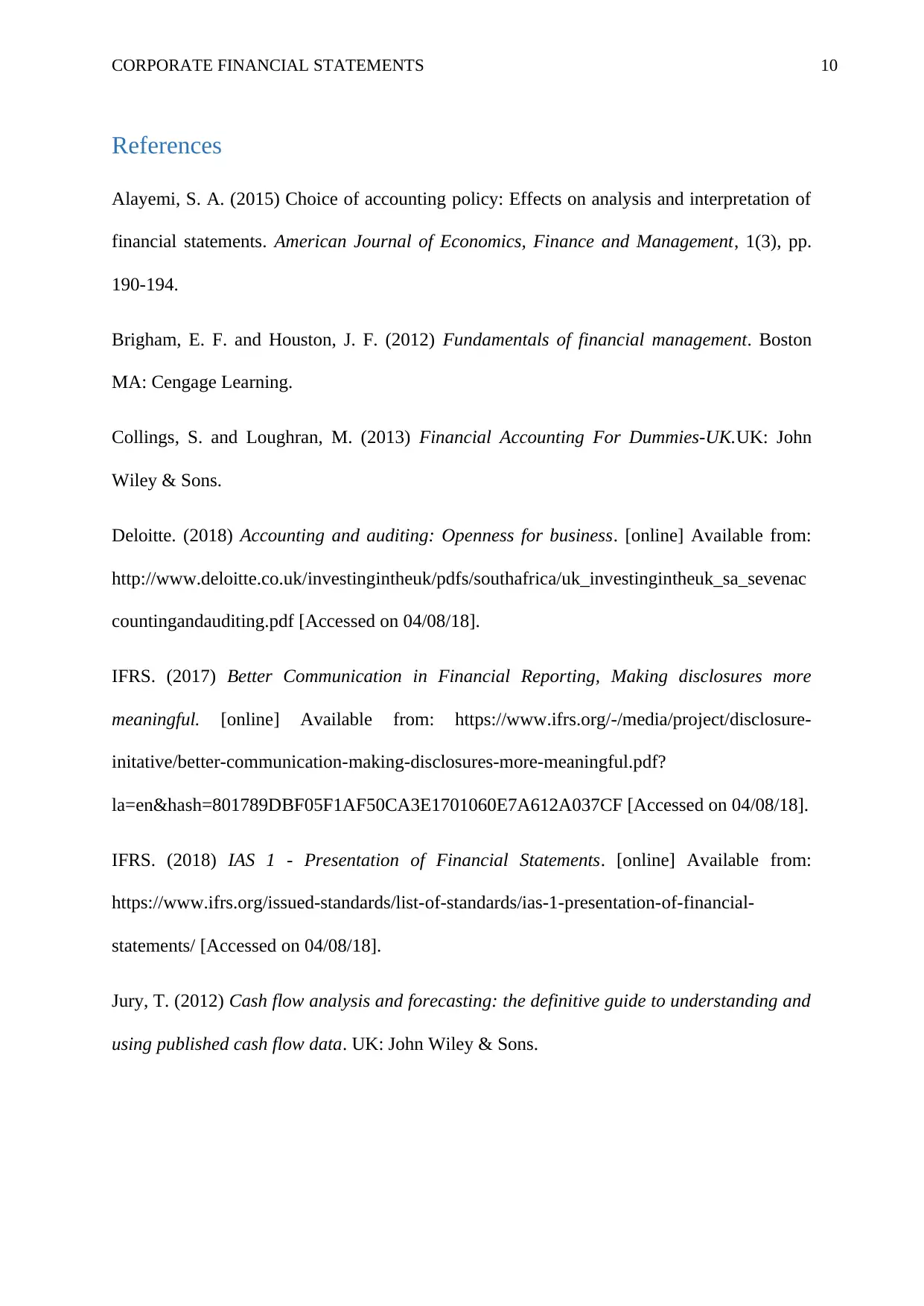
CORPORATE FINANCIAL STATEMENTS 10
References
Alayemi, S. A. (2015) Choice of accounting policy: Effects on analysis and interpretation of
financial statements. American Journal of Economics, Finance and Management, 1(3), pp.
190-194.
Brigham, E. F. and Houston, J. F. (2012) Fundamentals of financial management. Boston
MA: Cengage Learning.
Collings, S. and Loughran, M. (2013) Financial Accounting For Dummies-UK.UK: John
Wiley & Sons.
Deloitte. (2018) Accounting and auditing: Openness for business. [online] Available from:
http://www.deloitte.co.uk/investingintheuk/pdfs/southafrica/uk_investingintheuk_sa_sevenac
countingandauditing.pdf [Accessed on 04/08/18].
IFRS. (2017) Better Communication in Financial Reporting, Making disclosures more
meaningful. [online] Available from: https://www.ifrs.org/-/media/project/disclosure-
initative/better-communication-making-disclosures-more-meaningful.pdf?
la=en&hash=801789DBF05F1AF50CA3E1701060E7A612A037CF [Accessed on 04/08/18].
IFRS. (2018) IAS 1 - Presentation of Financial Statements. [online] Available from:
https://www.ifrs.org/issued-standards/list-of-standards/ias-1-presentation-of-financial-
statements/ [Accessed on 04/08/18].
Jury, T. (2012) Cash flow analysis and forecasting: the definitive guide to understanding and
using published cash flow data. UK: John Wiley & Sons.
References
Alayemi, S. A. (2015) Choice of accounting policy: Effects on analysis and interpretation of
financial statements. American Journal of Economics, Finance and Management, 1(3), pp.
190-194.
Brigham, E. F. and Houston, J. F. (2012) Fundamentals of financial management. Boston
MA: Cengage Learning.
Collings, S. and Loughran, M. (2013) Financial Accounting For Dummies-UK.UK: John
Wiley & Sons.
Deloitte. (2018) Accounting and auditing: Openness for business. [online] Available from:
http://www.deloitte.co.uk/investingintheuk/pdfs/southafrica/uk_investingintheuk_sa_sevenac
countingandauditing.pdf [Accessed on 04/08/18].
IFRS. (2017) Better Communication in Financial Reporting, Making disclosures more
meaningful. [online] Available from: https://www.ifrs.org/-/media/project/disclosure-
initative/better-communication-making-disclosures-more-meaningful.pdf?
la=en&hash=801789DBF05F1AF50CA3E1701060E7A612A037CF [Accessed on 04/08/18].
IFRS. (2018) IAS 1 - Presentation of Financial Statements. [online] Available from:
https://www.ifrs.org/issued-standards/list-of-standards/ias-1-presentation-of-financial-
statements/ [Accessed on 04/08/18].
Jury, T. (2012) Cash flow analysis and forecasting: the definitive guide to understanding and
using published cash flow data. UK: John Wiley & Sons.
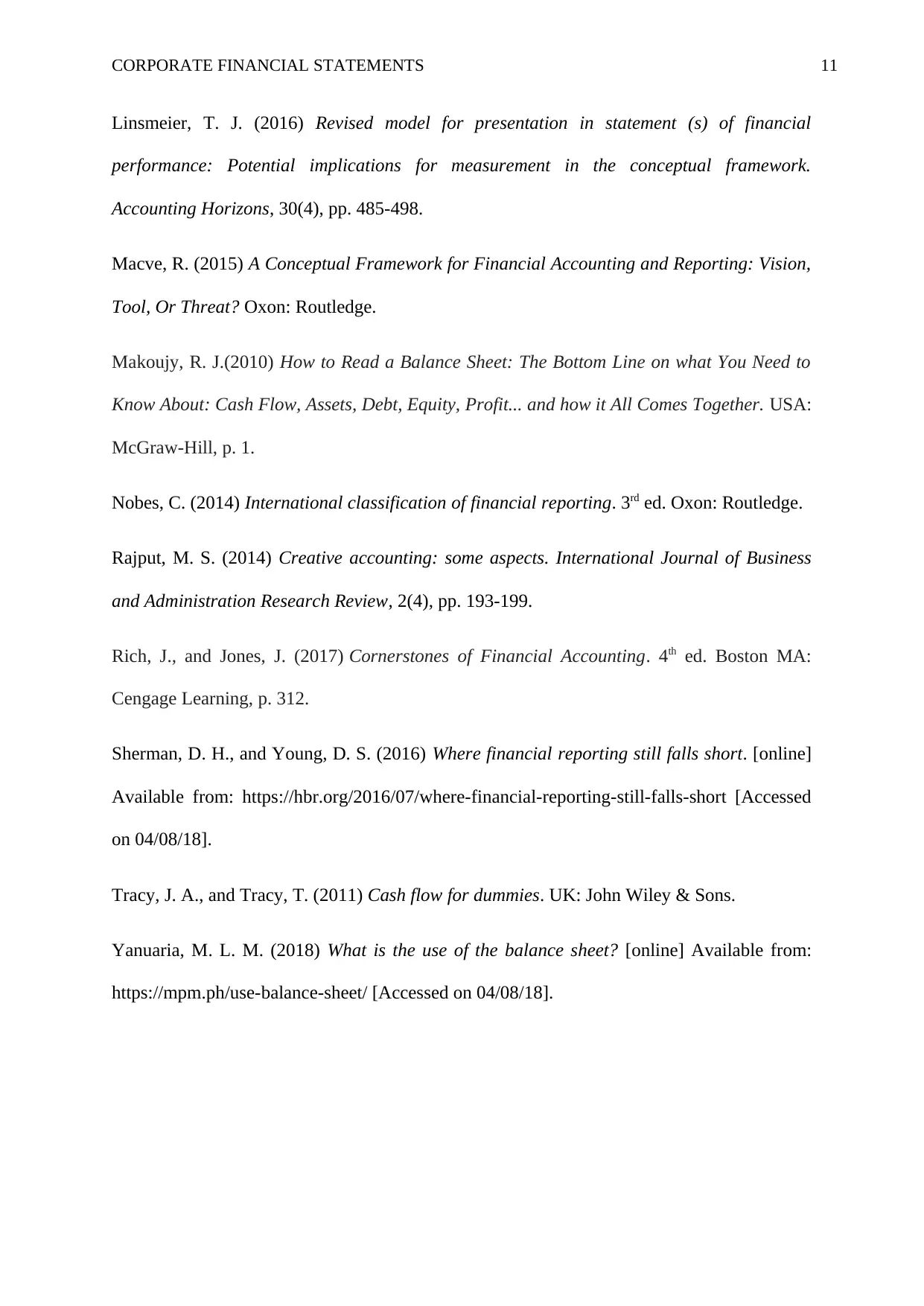
CORPORATE FINANCIAL STATEMENTS 11
Linsmeier, T. J. (2016) Revised model for presentation in statement (s) of financial
performance: Potential implications for measurement in the conceptual framework.
Accounting Horizons, 30(4), pp. 485-498.
Macve, R. (2015) A Conceptual Framework for Financial Accounting and Reporting: Vision,
Tool, Or Threat? Oxon: Routledge.
Makoujy, R. J.(2010) How to Read a Balance Sheet: The Bottom Line on what You Need to
Know About: Cash Flow, Assets, Debt, Equity, Profit... and how it All Comes Together. USA:
McGraw-Hill, p. 1.
Nobes, C. (2014) International classification of financial reporting. 3rd ed. Oxon: Routledge.
Rajput, M. S. (2014) Creative accounting: some aspects. International Journal of Business
and Administration Research Review, 2(4), pp. 193-199.
Rich, J., and Jones, J. (2017) Cornerstones of Financial Accounting. 4th ed. Boston MA:
Cengage Learning, p. 312.
Sherman, D. H., and Young, D. S. (2016) Where financial reporting still falls short. [online]
Available from: https://hbr.org/2016/07/where-financial-reporting-still-falls-short [Accessed
on 04/08/18].
Tracy, J. A., and Tracy, T. (2011) Cash flow for dummies. UK: John Wiley & Sons.
Yanuaria, M. L. M. (2018) What is the use of the balance sheet? [online] Available from:
https://mpm.ph/use-balance-sheet/ [Accessed on 04/08/18].
Linsmeier, T. J. (2016) Revised model for presentation in statement (s) of financial
performance: Potential implications for measurement in the conceptual framework.
Accounting Horizons, 30(4), pp. 485-498.
Macve, R. (2015) A Conceptual Framework for Financial Accounting and Reporting: Vision,
Tool, Or Threat? Oxon: Routledge.
Makoujy, R. J.(2010) How to Read a Balance Sheet: The Bottom Line on what You Need to
Know About: Cash Flow, Assets, Debt, Equity, Profit... and how it All Comes Together. USA:
McGraw-Hill, p. 1.
Nobes, C. (2014) International classification of financial reporting. 3rd ed. Oxon: Routledge.
Rajput, M. S. (2014) Creative accounting: some aspects. International Journal of Business
and Administration Research Review, 2(4), pp. 193-199.
Rich, J., and Jones, J. (2017) Cornerstones of Financial Accounting. 4th ed. Boston MA:
Cengage Learning, p. 312.
Sherman, D. H., and Young, D. S. (2016) Where financial reporting still falls short. [online]
Available from: https://hbr.org/2016/07/where-financial-reporting-still-falls-short [Accessed
on 04/08/18].
Tracy, J. A., and Tracy, T. (2011) Cash flow for dummies. UK: John Wiley & Sons.
Yanuaria, M. L. M. (2018) What is the use of the balance sheet? [online] Available from:
https://mpm.ph/use-balance-sheet/ [Accessed on 04/08/18].
⊘ This is a preview!⊘
Do you want full access?
Subscribe today to unlock all pages.

Trusted by 1+ million students worldwide
1 out of 12
Related Documents
Your All-in-One AI-Powered Toolkit for Academic Success.
+13062052269
info@desklib.com
Available 24*7 on WhatsApp / Email
![[object Object]](/_next/static/media/star-bottom.7253800d.svg)
Unlock your academic potential
Copyright © 2020–2025 A2Z Services. All Rights Reserved. Developed and managed by ZUCOL.





